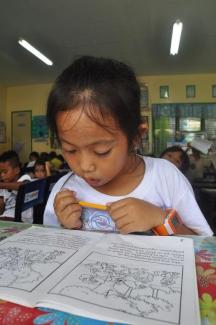August 2018 — Crisha*, 7, lives on a remote islet called Silagon in the Philippines’ central region of Cebu. Electricity, fresh water and produce are scarce and expensive for the 300 people who live there. Families must frequently visit the main island of Bantayan — about 40 minutes away by boat — to get basic necessities.
Helping to steer the boat with a bamboo pole, Crisha and her friends make this trip each day to attend school. Twice, the girls fell overboard when they lost their balance while prying their pole free from rocks. During low tide, they wade in ankle-deep water.
Despite these challenging circumstances, the girls go to school every day.
“I don’t want to be absent because I don’t want to miss our lessons,” says Crisha, who is currently in third grade.
Every day that Crisha crosses the sea to get to school, she is taking a step toward her dream of becoming a teacher. Crisha’s parents admire their daughter’s drive and ambition. Her mother, Amy*, did not finish high school and her father only completed four years of primary education.
“We want a better future for our daughters,” says Amy. “They have better opportunities if they are educated.”
Hermida Alota was Crisha’s teacher in second grade. “Crisha was eager to learn. She became even more interested when I made my lessons more fun through storytelling and interactive activities.”
Alota credits the change in her teaching practices to USAID’s Basa Pilipinas (Read Philippines) project. She was among the teachers whom USAID, in partnership with the Philippine Department of Education, trained to boost literacy among early grade learners. From 2013 to 2018, the project provided nearly 10.5 million copies of teacher guides, storybooks and other education aids to 3,000 public elementary schools, including the school where Alota teaches.
“Because I have all the tools I need as a teacher, I can focus on engaging my students more meaningfully in class,” she says.
Alota lends books to her students to read at home. These materials keep Crisha occupied on rainy days when it is too dangerous to take the boat to school.
By training over 19,000 teachers and school administrators and providing teaching and learning materials to schools, USAID has helped unlock the potential of over 1.8 million students from kindergarten to third grade. The Department of Education has since adopted the learning materials and will distribute them throughout the Philippines.
For Crisha, these measures have sparked an even greater interest to come to school and learn.
“She enjoys school more than ever. When she comes home, she tells us everything that she did in class. After dinner, she reads her books to us,” says her mother.
*Full name withheld to protect identity.
LINKS
Follow @USAID_Manila, on Facebook, on Flickr, on YouTube
,“We want a better future for our daughters. They have better opportunities if they are educated.”

Karen Rivera for USAID
